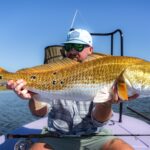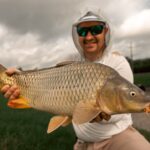
Louisiana Bull Reds Up for Harvest Again: H.B. 604 Must Not Pass
Photo Credit: Carter Abramson | Trevor Johnson Every now and then, we encounter something so
A staple of the Northeast forage base and a favorite prey of bluefin tuna and striped bass, Atlantic herring remains at near historic low biomass levels, according to the new 2024 Management Track Assessment. Subject to intense fishing pressure since the early 2000s, declared overfished in 2020, under a rebuilding plan since 2022, and experiencing persistently terrible recruitment since 2010, ASGA highly anticipated this assessment to determine if Atlantic herring may finally turn a corner. Well, the assessment results are “devastating,” as a Maine fishery manager described it. The New England Council will consider catch limits this week and discussions will certainly center around what else can be done to promote successful rebuilding…at least we hope.

Just look how bleak the primary data-points are for herring coming out of the 2024 assessment…Consistent terrible recruitment and three decades of declining biomass…
How did we get here?
During stock assessment presentations and SSC discussions this summer, the predominant culprit for the collapsed herring stock (and the directed fishery) was sustained below average recruitment since 2010. 10+ years of below-average recruitment are undoubtedly fueling the decline in herring biomass. Still, this realization begs several questions: what is fueling over a decade of consistently terrible recruitment? How strong is the stock-recruitment relationship? And what could management have done differently for a healthier herring resource?
The drivers of herring recruitment remain a significant unknown for fisheries scientists and the stock assessment team, but something is happening. Even with the terrible recruitment, the pressure and efficiency of the directed herring fishery cannot be ignored. Just look at this chart depicting Atlantic herring fishing mortality:

In the early 2000s, anglers and smaller commercial fishermen (even commercial herring fishermen) began sounding the alarms with their concerns about the directed herring fishery, specifically the mid-water trawl fleet. These concerns centered around the incredible efficiency of the mid-water trawl gear to remove millions of Atlantic herring—mostly the pair trawlers—coupled with the fleet fishing on hyper-aggregated spawning herring. Their concerns moved the needle with an inshore mid-water trawl exclusion zone (which has since been axed via a federal judge) and some other management levers—narrow, targeted inshore spawning closures in the Gulf of Maine, bycatch limits, and an ABC control rule that sets aside some herring for their role as forage. But, management decisions have failed over the last 15 years to stem this steep population decline, reduce high fishing mortality (only until recently was fishing mortality effectively constrained), and react to more than a decade of failed spawns. That might not be entirely fair, as annual catch limits have declined since 2008. But all of this begs the question: while the lack of recruitment is the underlying problem with Atlantic herring, shouldn’t Managers still have acted far more conservatively to keep more herring in the water, knowing how little fish were recruiting? We think so.
2024 Stock Assessment Informing 2025 Specifications
The release of the 2024 Atlantic Herring Stock Assessment sounded alarm bells for everyone who works on and cares about this critical forage species. The risk of overfishing this year in 2024 is high, and the rebuilding odds crashed (again). In this new Assessment, successful rebuilding projections (a 50% chance of biomass being at target levels) shifted from 2028 to 2031. So, there are immediate, short-term concerns about removing too many fish and continued long-term uncertainty about restoring the stock’s biomass levels.
Throughout this summer, herring management bodies reviewed and discussed stock assessment presentations and now have to make decisions about catch limits for 2025 (and potentially 2026 and 2027). Based on the 2024 Stock Assessment, the New England Fishery Management Council’s SSC and Herring Committee recommends substantially reduced 2025-2027 specifications. Applying the Herring FMP’s ABC Control Rule results in a 2025 annual catch limit of 2,710mt; the lowest US catch advice in the history of the fishery.

Annual catch limits increased in 2023 and 2024 (to 12,429mt and 19,141mt, respectively) based on stock assessment projections, which painted a rosier outlook for the fishery—the SSC noted a “major retrospective pattern” in this most recent 2024 stock assessment that overestimated biomass and underestimated fishing mortality. Therefore, catch limits for 2023-2025 were likely too high. So, if the fishery catches all of the ACL in 2024, the risk of overfishing is high, and there is an immediate need to revise specifications in 2025. The 2025 annual catch limit for Atlantic herring represents a nearly 90% reduction compared to 2024, and the amount of herring available to predators continues to be incredibly low—none of this is good.
Now, the NEFMC and, to a lesser degree, the Atlantic States Marine Fisheries Commission have challenging decisions to make. Will they do anything in 2024 to reduce fishing mortality? Will they be able to implement revised 2025-2027 specifications by January 1 of 2025? Most importantly, what can they do now to promote rebuilding?
Don’t forget about Amendment 10, the NEFMC’s action to reconsider spatial/temporal management, contribute to rebuilding and Optimum Yield, minimize user conflicts, and enhance river herring and shad. Amendment 10 will continue progressing later this winter, and we cannot forget about it. ASGA remains focused on Amendment 10 and will continue advocating for improved herring management that contributes to rebuilding and more efficiently distributes the benefits of an abundant herring resource. Just because quotas and directed herring fishing effort are at historically low levels does not make it OK to hit the “pause button” on Amendment 10—in fact, now is the perfect time to approve Amendment 10 with strong precautionary management strategies for when herring do, hopefully, rebuild.
This species is too critical to marine ecosystems in the Northeast to give up on and blame factors out of our control.
Considering all of this—record low biomass estimates, assessment uncertainties, and diminishing rebuilding odds–Atlantic herring management must look inward and do what is right for this resource. Stay tuned for a rundown on the NEFMC discussions and actions on Atlantic herring later this month.

Photo Credit: Carter Abramson | Trevor Johnson Every now and then, we encounter something so

This past weekend, ASGA proudly sponsored the Dirty Carp Tournament in Louisiana — and no, you didn’t misread that.

After years of data pouring in from The Albie Project, advocacy, persistence, and support from

This morning, the Connecticut Environment Committee held a hearing on House Bill 6248, a bill
We rely on our members and donations to keep fighting for a sustainable tomorrow in marine conservation.
GIVE THE GIFT OF FISHERIES CONSERVATION THIS HOLIDAY SEASON. SHOP ASGA GOODS THAT FUND FISHERIES RESEARCH & ADVOCACY CAMPAIGNS
JOIN ASGA IN CALLING FOR CRITICAL MANAGEMENT ACTION AFTER YEARS OF SPAWN FAILURES & POOR MANAGEMENT.
By using this website, you agree to our use of cookies. We use cookies to provide you with a great experience and to help our website run effectively. To learn more, please review our privacy policy.
2 Responses
At what point will government agencies stop the commercial overfishing of our stocks? Once they are gone, we will be on the road to Soylent Green.
When my Son’s were young, 5 and 10 years old, I would take them to the middleboro herring run. With very small fishing nets, reach down and 4 or 5 would be in thier little nets, there were so many back then. Year or so later my boy would help with thier little nets when the environmental people came with a tank truck to restock another river/ pond. ( I forget which, it has been awhile). About a year later, the a 3 year moratorium came down and my Son’s could not touch them any more, they never kept them out of the water very long I saw to that. My Son’s are now 22 and 27.
I understand herring are a good source of vitamin E. It’s a big industry.
Industry like that might be a place to start, dare I say regulate.
My opinion is the herring fisheries have been a failure. It seems like any lobbying falls on the side of the “deep pockets”. In the end my Grand Son’s will never share the experience thier Dads did.